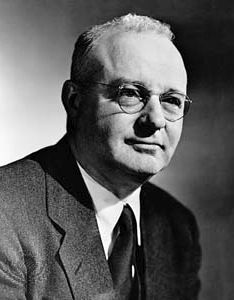Thomas Midgley (Thomas Midgley)

Midgley began working at General Motors in 1916. In December 1921, while working under the direction of Charles Kettering at Dayton Research Laboratories, a subsidiary of General Motors, Midgley discovered that the addition of Tetraethyllead to gasoline prevented “knocking” in internal combustion engines. The company named the substance “Ethyl”, avoiding all mention of lead in reports and advertising. Oil companies and automobile manufacturers, especially General Motors which owned the patent jointly filed by Kettering and Midgley, promoted the TEL additive as a superior alternative to ethanol or ethanol-blended fuels, on which they could make very little profit. In December 1922, the American Chemical Society awarded Midgley the 1923 Nichols Medal for the “Use of Anti-Knock Compounds in Motor Fuels”. This was the first of several major awards he earned during his career.
In 1923, Midgley took a prolonged vacation to cure himself of lead poisoning. “After about a year’s work in organic lead,” he wrote in January 1923, “I find that my lungs have been affected and that it is necessary to drop all work and get a large supply of fresh air.” He went to Miami, Florida for convalescence. In April 1923, General Motors created the General Motors Chemical Company (GMCC) to supervise the production of TEL by the DuPont company. Kettering was elected as president, and Midgley was vice president. However, after two deaths and several cases of lead poisoning at the TEL prototype plant in Dayton, Ohio, the staff at Dayton was said in 1924 to be “depressed to the point of considering giving up the whole tetraethyl lead program.” Over the course of the next year, eight more people would die at DuPont’s Deepwater, New Jersey plant.
In 1924, dissatisfied with the speed of DuPont’s TEL production using their “bromide process”, General Motors and Standard Oil Company of New Jersey (now known as ExxonMobil) created the Ethyl Gasoline Corporation to produce and market TEL. Ethyl Corporation built a new chemical plant using a high-temperature ethyl chloride process at the Bayway Refinery in New Jersey. Within the first two months of its operation however, the new plant was plagued by more cases of lead poisoning, hallucinations, insanity, and then five deaths in quick succession.
On October 30, 1924, Midgley participated in a press conference to demonstrate the apparent safety of TEL. In this demonstration, he poured TEL over his hands, then placed a bottle of the chemical under his nose and inhaled its vapor for sixty seconds, declaring that he could do this every day without succumbing to any problems whatsoever. However, the State of New Jersey ordered the Bayway plant to be closed a few days later, and Jersey Standard was forbidden to manufacture TEL there again without state permission. Midgley sought treatment for lead poisoning in Europe a few months after his demonstration at the press conference. Midgley was relieved of his position as vice president of GMCC in April 1925, reportedly due to his inexperience in organizational matters, but he remained an employee of General Motors.
In the late 1920s, air conditioning and refrigeration systems employed compounds such as ammonia (NH3), chloromethane (CH3Cl), propane, and sulfur dioxide (SO2) as refrigerants. Though effective, these were toxic, flammable or explosive and, in the event of leakage, could result in serious illness, injury or even death. The Frigidaire division of General Motors, at that time a leading manufacturer of such systems, sought a non-toxic, non-flammable alternative to these refrigerants. Kettering, the vice president of General Motors Research Corporation at that time, assembled a team – that included Midgley and Albert Leon Henne – to develop such a compound.
The team soon narrowed their focus to alkyl halides (the combination of carbon chains and halogens), which were known to be highly volatile (a requirement for a refrigerant) and also chemically inert. They eventually settled on the concept of incorporating fluorine into a hydrocarbon. They rejected the assumption that such compounds would be toxic, believing that the stability of the carbon–fluorine bond would be sufficient to prevent the release of hydrogen fluoride or other potential breakdown products. The team eventually synthesized dichlorodifluoromethane, the first chlorofluorocarbon (CFC), which they named “Freon”. This compound is more commonly referred to today as “Freon 12”, or “R 12”. Freon and other CFCs soon replaced the various toxic or explosive substances previously used as refrigerants, and were later used in other applications, such as propellants in aerosol spray cans and asthma inhalers. The Society of Chemical Industry awarded Midgley the Perkin Medal in 1937 for this work.
In 1941, the American Chemical Society gave Midgley its highest award, the Priestley Medal. This was followed by the Willard Gibbs Award in 1942. He also held two honorary degrees and was elected to the United States National Academy of Sciences. In 1944, he was elected president and chairman of the American Chemical Society. In 1940, at the age of 51, Midgley contracted poliomyelitis, which left him severely disabled. This led him to devise an elaborate system of strings and pulleys to help others lift him from bed. This system was the eventual cause of his own death when he was entangled in the ropes of this device and died of strangulation at the age of 55.
Born
- May, 19, 1889
- USA
- Beaver Falls, Pennsylvania
Died
- November, 02, 1944
- USA
- Worthington, Ohio
Cause of Death
- strangulation

